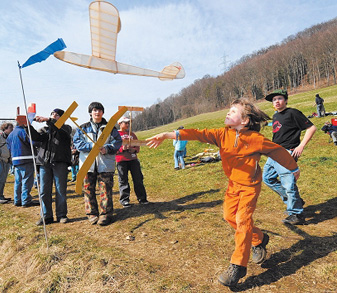Free flight, without remote control, the high art of aerodynamics
Free flight means flying without remote control, the models are in a "free" gliding flight after the start. Free flight is the oldest branch of today's very versatile model flying. However, new technologies are constantly contributing to further development, so that a wide range exists from simpler beginner models to competition models of the most modern technology.
Free flight models are designed to fly independently for as long as possible with the best flight stability, taking advantage of updrafts. This is achieved by aerodynamically and in terms of strength and weight optimized designs, as well as an autonomous control in the model, which depending on the requirement can be quite simple to electronically controlled by microprocessor.
Free flight is fun and sport at the same time. Freeflyers meet at regional, Swiss, European and World Championships, as well as in the World Cup of Freeflyers. At these competitions the flight time is decisive, whereby the flight times of several runs are added up for the overall result. In addition to good models, a lot of tactics and sensitivity for the weather conditions are required. The take-off is also of decisive importance, which must be trained accordingly. Free flight thus promotes a wide range of skills in technology, sports and nature.
In free flight there are quite a number of categories, the most important of which are:
- F1A Sail models brought to altitude by the pilot with a line by running.
- F1B sail models with rubber motor, a strung rubber cord drives the propeller.
- F1C glider models with combustion engine, the engine brings the model up to altitude in 5 seconds.
- F1D Saalflugmodelle with rubber motor, total weight 1.8 grams, wingspan 55 cm.
- F1E glider models for slope flight with course control on the compass principle.
- F1Q sail models with electric motor, the motor is in operation for 10 to 20 seconds at takeoff.
- A1 Simple student models for slope flying. Wingspan 100 to 150 cm.
Wingspans vary somewhat by category and range from 150 to 300 cm, with model weights from 200 to 800 grams.
Depending on the inclination, the models are designed and built by oneself or ready-made models are purchased, which are manually produced by "professional" freeflyers. In the case of self-building, a wide variety of prefabricated parts, mechanical components and controls can be purchased.

The technical commission F1 supports all interested persons, or also schools and work teachers, with words and deeds with the building as well as with the flying. Furthermore, the commission organizes together with the clubs all the annual activities.
Fascination free flight - joy of flying, technology, nature and sport ...
|